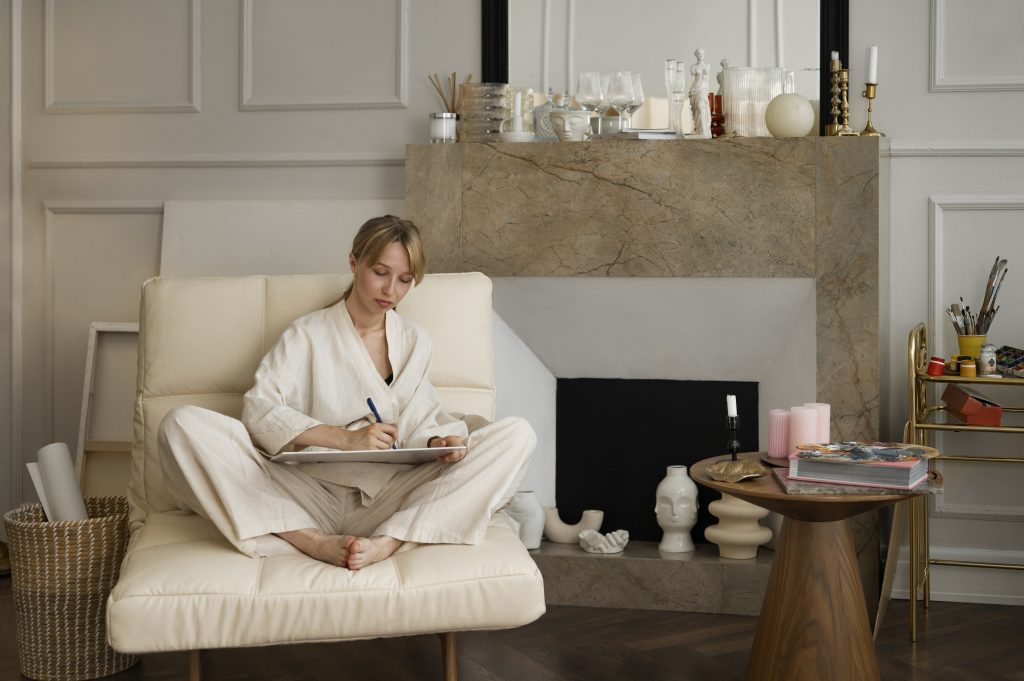Creating Wellness Spaces in Your Home
Natalie Brooks August 19, 2025
Creating wellness spaces at home has never been more relevant—or more innovative. In 2025, design and technology are converging with health science to reshape how we think about living spaces. Home is no longer just a place to eat and sleep. It has become a wellness hub—supporting rest, recovery, mindfulness, and even biohacking practices.
The trend is clear: wellness spaces at home are no longer a luxury—they’re an essential part of modern living.

Why Wellness Spaces at Home Matter in 2025
The conversation around wellness at home has grown from a niche design trend into a mainstream priority. Several factors explain this rise:
- Pandemic-driven habits became permanent. The global lockdowns forced people to rethink their spaces. Spare rooms became yoga studios, bathrooms became spa retreats, and balconies became mindfulness corners. Those habits didn’t fade; they evolved.
- Mental health awareness is at an all-time high. With anxiety and stress on the rise, home environments are expected to be more than stylish—they must actively support emotional well-being.
- Technology is driving accessibility. Features like circadian lighting, smart aromatherapy diffusers, and acoustic zoning—once found only in high-end builds—are increasingly affordable and DIY-friendly.
- Design is health-driven. Wellness in 2025 isn’t about décor trends; it’s about optimizing everyday living through thoughtful choices in materials, sound, light, and function.
The big picture? Wellness spaces at home aren’t about indulgence—they’re about necessity.
The Core Trends Defining Wellness Spaces at Home in 2025
1. Acoustic Sanctuaries & Sensory Architecture
One of the fastest-growing areas in wellness-focused design is what experts call silent architecture. Acoustic sanctuaries create soundproofed, interference-free areas inside the home where people can meditate, read, or decompress.
- Elements to include:
- Noise-absorbing wall panels or fabrics.
- Soundscaping with gentle nature-inspired audio.
- Layouts that reduce noise “leak” from appliances or HVAC systems.
These spaces are not just aesthetic—they have measurable health benefits, supporting deeper focus, lower blood pressure, and improved sleep.
Case Study: A design studio in Copenhagen recently retrofitted apartments with modular “sound cocoons”—small pods layered with acoustic textiles. Residents reported better concentration and reduced stress levels, turning ordinary apartments into sensory wellness havens.
2. Infrared Saunas and Multipurpose Wellness Rooms
Infrared saunas are no longer reserved for spas and wellness resorts. In 2025, they’re showing up in suburban homes, high-rise condos, and even compact apartments. Prices are dropping, and portable models are available for smaller spaces.
At the same time, wellness rooms are replacing traditional “home gyms.” Instead of rows of dumbbells, these rooms are flexible environments that accommodate yoga, meditation, light therapy, or sauna use.
Why this matters: A single room now serves as a personal retreat, reflecting the multifunctional demands of urban lifestyles.
Practical Tip: If you can’t dedicate a whole room, carve out corners—a meditation alcove in the living room or an aromatherapy corner in the bedroom.
3. Biophilic and Emotion-Driven Design
Humans crave connection to nature, and in 2025, biophilic design is stronger than ever. This goes beyond adding a houseplant. It’s about designing emotional resonance into living spaces.
- Use tactile, natural materials like stone, wood, and linen.
- Integrate vertical gardens or moss walls.
- Choose calming palettes rooted in earth tones and soft greens.
- Maximize airflow and daylight.
Case Study: In Tokyo, a mid-rise apartment complex redesigned balconies into mini-wellness retreats with vertical herb gardens and small meditation decks. Residents reported a stronger sense of grounding despite dense urban living.
4. Spa-Like Serenity and At-Home Retreats
The spa-at-home trend continues to dominate. Bathrooms and bedrooms are being reimagined as retreat-like sanctuaries. Think heated floors, steam showers, and aromatherapy diffusion built into the home design.
- Indirect lighting creates mood shifts for morning vs. evening.
- Ergonomic lounge chairs or chaise seating enhance rest.
- High-quality natural textiles, such as organic cotton and bamboo, add a tactile sense of calm.
Even small details—like a stone bowl of essential oils or a shower designed for both hot and cold therapy—can make a big impact.
5. Smart Wellness Integration
Wellness is being built into the very structure of smart homes. Voice assistants now go beyond controlling thermostats—they manage air quality, circadian lighting, and even soundscapes.
- Smart windows adjust transparency based on daylight cycles.
- AI-driven air purifiers learn patterns and reduce allergens at peak times.
- Automated blackout shades optimize melatonin cycles for deeper sleep.
Future Outlook: Expect AI-driven personalization, where your home adapts wellness features based on your biometrics—lighting dims as your heart rate lowers, or scent diffusers trigger during high-stress work hours.
6. Biohacking Homes
Biohacking has jumped from Silicon Valley into mainstream wellness culture. More homeowners are experimenting with longevity-focused features:
- Hyperbaric oxygen therapy chambers.
- Cold plunge pools in backyards.
- Red-light therapy walls.
- Aromatherapy steam rooms.
Case Study: A Scottsdale couple built their home as a full-body wellness ecosystem: cold plunge, sauna, aromatherapy steam, and UV air filters. Their intent? To extend both energy and lifespan.
While not every household will install oxygen chambers, the trend signals how wellness is shaping high-end architecture.
Beyond Interiors: Outdoor Wellness Spaces
Wellness doesn’t stop at the threshold of your living room. In 2025, outdoor spaces are being designed as extensions of home wellness.
- Balcony sanctuaries: Compact urban apartments use foldable yoga decks and balcony herb gardens.
- Backyard cold plunge: Affordable cold plunge tubs are becoming common suburban wellness features.
- Outdoor meditation pavilions: Small shelters or pergolas for mindfulness and breathwork.
- Eco pools: Natural swimming pools that avoid chlorine and use plant filtration systems.
These designs connect residents with both wellness and sustainability, merging self-care with eco-conscious living.
Practical Guide: How to Create Your Own Wellness Space at Home
Building your wellness space doesn’t require a major renovation. Here’s a framework anyone can use:
1: Define Your Purpose
Ask: Do I want this space for meditation, physical recovery, or stress relief? Your answer determines everything else.
2: Choose the Location
- Spare room = multifunction wellness room.
- Bedroom corner = meditation or aromatherapy zone.
- Bathroom = spa-style retreat.
- Balcony/backyard = outdoor mindfulness corner.
3: Layer the Senses
- Sound: Add noise-cancelling curtains, acoustic rugs, or water features.
- Light: Install dimmers, warm bulbs, or circadian lighting strips.
- Smell: Use diffusers or natural plants like lavender or eucalyptus.
- Touch: Choose textiles like organic cotton, wool, or bamboo.
4: Add Core Wellness Features
- Budget-friendly: meditation cushions, yoga mat, diffuser.
- Mid-range: infrared sauna blanket, circadian lamp, weighted blanket.
- High-end: sauna cabin, smart shower, or cold plunge pool.
5: Personalize
This is where your values come in. Add personal touches: books, cushions, artwork, or family heirlooms that give comfort.
Step 6: Test and Refine
Spend time in the space and notice how it feels. Adjust textures, lighting, or layout until it flows.
Final Thoughts
Wellness spaces at home in 2025 reflect a cultural shift: our homes are no longer passive backdrops, but active participants in our health and happiness. From sensory architecture to biohacking features, from spa-like bathrooms to outdoor sanctuaries, the home has become a platform for well-being.
The trend is here to stay. The question is not if you should create wellness spaces at home—but how you’ll shape yours to fit your lifestyle.
References
- American Society of Interior Designers. (2025). ASID explores the influence of joy, wellness, and sustainability on 2025 interior design trends. Available at: https://www.iands.design (Accessed: 19 August 2025).
- News.com.au. (2025, March). Dramatic spike in Aussies installing infrared saunas at home. Available at: https://www.news.com.au (Accessed: 19 August 2025).
- Livingetc. (2025, January). 5 Architecture trends set to take over in 2025. Available at: https://www.livingetc.com (Accessed: 19 August 2025).







